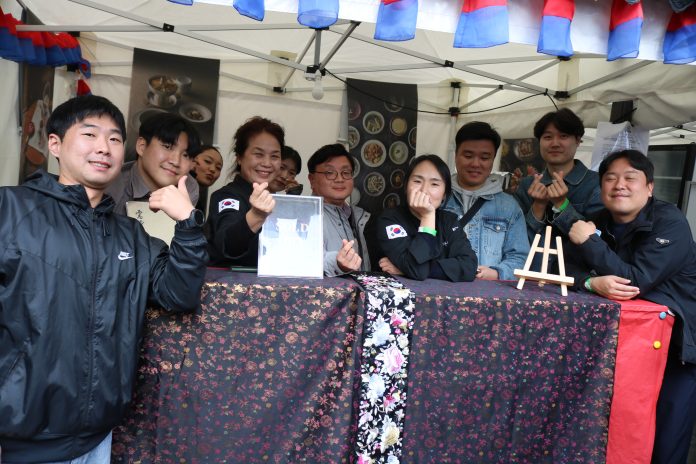London Post: Can you tell us the story behind this 500-year-old traditional recipe and how it has been passed down through generation?
Kim Do-eun: In the past many books were weak at fire, so our ancestors keep many books under the ground to protect from fire. After that it has been forgotten. However, one day there was a big flood in Andong. Books buried in the ground were discovered after the flood. At this time, 30,000 books were discovered, and SoowoonJapbang was also discovered at this time. After that, our ancestors kept the book well, and it was passed down to me, including my mother-in-law.
LP: What makes this recipe unique compared to other traditional Korean dishes?
Kim Do-eun: Compared to other traditional foods, the menu is very diverse. Considering that the number of alcohol and food records was written in same time, the pairing culture was already practiced and pursued at that time. Also, the technique of fermenting meat, fish, and vegetables is unique. For example, the method of applying oil to eggplants, fermenting them, drying them, and then grilling them like meat over an open flame cannot be found in other traditional foods in Korea. Furthermore, soowoonjapbang’s soju, Korean style whiskey, was already made and consumed in the 15th century.
LP: How has Andong’s agricultural stability influenced the preservation of traditional recipes?
Kim Do-eun : It remained same. Andong has been a very good region where many crops were grown in good conditions. So, the ingredients have been maintained until now, and since we cook based on them, there is no change in the recipe.
LP:What are the key ingredients in the recipe, and how do they contribute to its distinctive flavor?
Kim Do-eun: The main ingredient in this recipe is fresh meat. That’s why we cook with fresh meat delivered locally every day. Fresh ingredients are a huge factor in determining the taste of food. And our family’s fermented paste determines the taste of food. Because these sauces are made by fermenting for a long time, they have a very deep flavor and play a huge role in determining the taste of food.
LP: Can you share ant special techniques or methods used in preparing this dish that have been preserved over the years?
Kim Do-eun: We don’t need any special skills or methods. Preserving food well can be said to be an art of continuously making it using fresh ingredients. Andong has been amphitheatric region for a long time and has clean air, fresh winds, and good soil. Since fresh ingredients are continuously supplied based on good soil, the taste of food can be well preserved just by maintaining it. And, as I mentioned earlier, the taste of food can be preserved because our family has continued well.
LP: What challenges do you face in preserving and cooking such an ancient recipe in modern times?
Kim Do-eun: Recently, we have come to enjoy food with beautiful atmosphere, plating, and pretty places. However, ancient food did not have the technology to make and plate the food beautifully. So, it was difficult to keep up with the recent trend of enjoying food with aesthetic elements. That’s why we pay attention to the plating of food and try to decorate the eating area beautiful.
LP: How do you think this traditional dish reflects the history and culture of Korea?
Kim Do-eun: SoowoonJabpang’s recipe book not only explains how to prepare food, but also provides etiquette for how to eat food. This etiquette is not just for nobles, but also includes etiquette that commoners must also follow. Therefore, it can be said that Soowon Japbang also expresses the virtues that all people who eat food should have. This shows that our ancestors have enjoyed Korean history and culture in their food since ancient times. Rather than simply making food, we incorporated Korean culture into the food so that the food could also represent that culture. When I came to Paris, I felt that France is very similar to Korea. It is very similar to Korea in that it has good air, good soil, and a terrain surrounded by the sea. So, it seems that a similar culture appears in food. Korean food has long been designed to make people very calm and polite. Likewise, I think the reason France is called the country of gentlemen stems from its food.
LP: What reactions or feedback do you get from people, both locals and international visitors, when they try this 500-year-old recipe?
Kim Do-eun: Many international visitors come to our Soowon Japbang restaurant every year. And this event also gave us the opportunity to welcome many international visitors. Their common response is that it is ‘happy food’. It is said that eating food makes you feel happy and calm. Also, we often say ‘it’s really delicious’, but we’re not just saying it’s delicious. They say it is ‘a taste you have never experienced before.’
LP: Can you tell us about your journey to be becoming a chef and what inspired you to pursue a career in culinary arts?
Kim Do-eun: Actually, when I was young, I really hated cooking. However, due to the cultural characteristics of Korea, the daughters of the family had no choice but to learn cooking from their mothers. So, I learned to cook little by little and developed my skills. And after I got married, I learned how to cook from my mother-in-law. That dish was Soowoon Japbang’s dish. Thanks to that, I am now able to become a chef who cooks the dishes of Soowon Japbang, which has been designated as a treasure of Korea. I have no regrets about choosing to learn this cuisine and enjoying it very much. Also, I am still working on improving my cooking skills.






